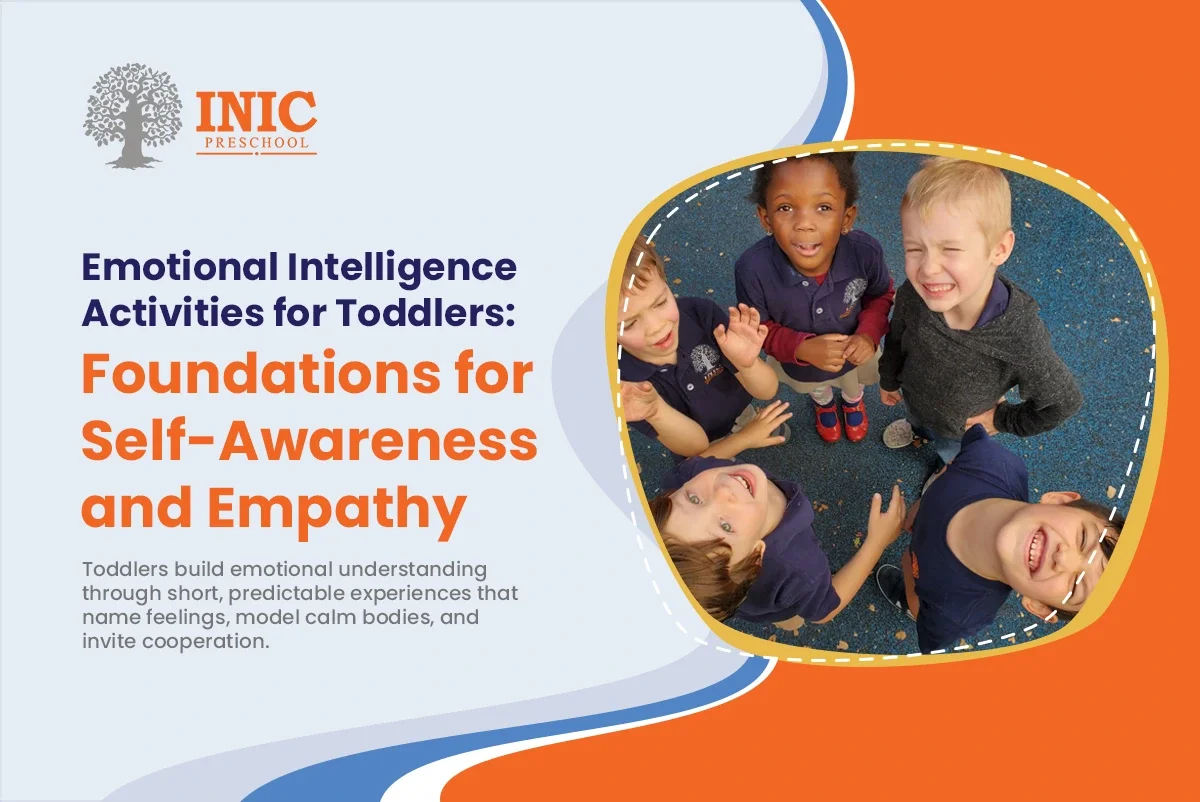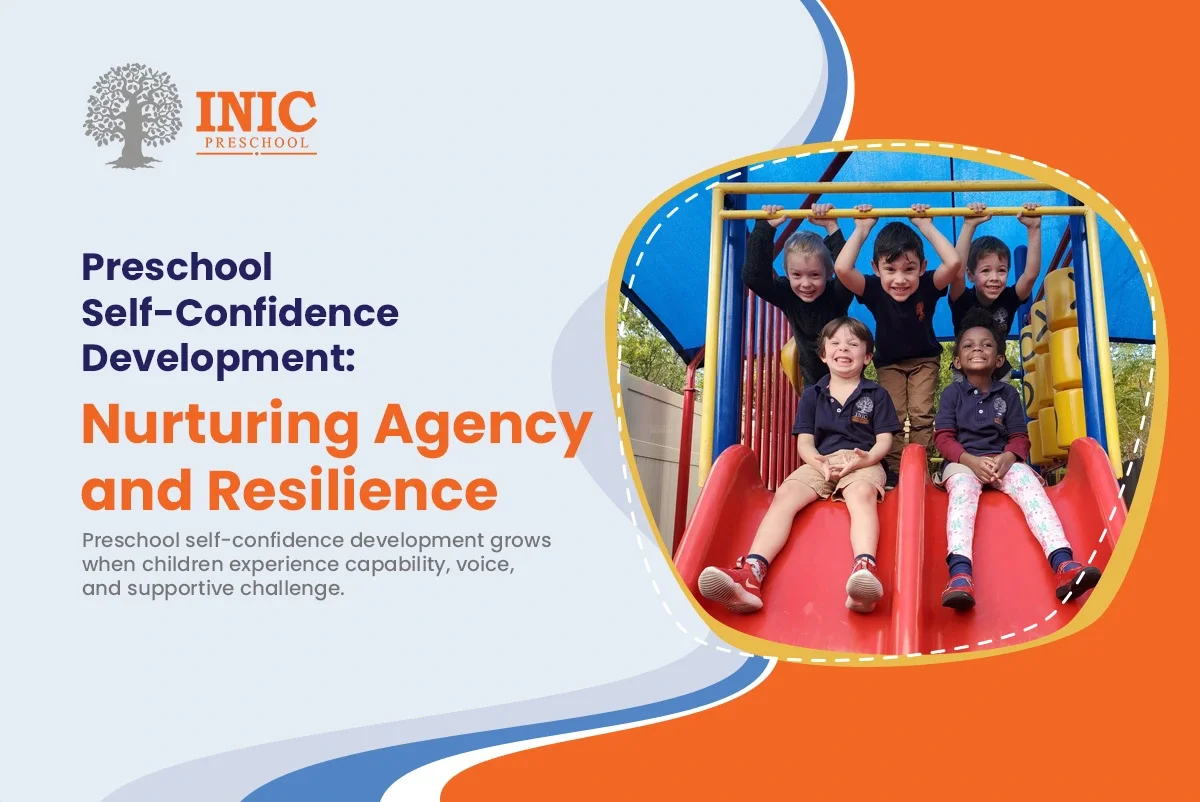How Social-Emotional Learning Prepares Your Child for Lifelong Success
Social-emotional learning for preschoolers builds the skills that help children thrive in school and beyond. During the early years, children learn to recognize emotions, manage impulses, show empathy, and solve problems with peers—foundations that support healthy behavior and strong relationships. Preschoolers practice self-awareness, self-regulation, social awareness, relationship skills, and responsible decision-making through purposeful play, language-rich interactions, and consistent routines.
These competencies reduce classroom stress, improve cooperation, and strengthen attention and persistence, creating a stable base for early literacy and numeracy. Families and educators now equip children for smoother transitions, positive school experiences, and lifelong success by nurturing confidence and resilience.
Emotional Intelligence Activities for Toddlers: Foundations for Self-Awareness and Empathy
Toddlers build emotional understanding through short, predictable experiences that name feelings, model calm bodies, and invite cooperation. Consistent routines and language help children connect sensations to words and actions. With patient guidance, these early practices strengthen self-awareness and empathy in everyday moments.
Naming Feelings With Visuals and Play
Young children learn best with concrete cues and repetition. Introduce simple feeling words during caregiving and play, pairing language with visuals and gestures.
Feeling cards or photos matched to facial expressions
Mirror play to copy “happy,” “sad,” or “frustrated” faces
Brief songs and picture books that label emotions
After labeling, link feelings to solutions, such as “You feel mad; let us squeeze the ball.” Over time, children begin to point, sign, or say the word that fits.
Turn-Taking and Waiting Games
Short, successful turns help toddlers practice impulse control and notice peers. Keep activities brief and predictable, with clear cues for whose turn it is.
Roll a ball back and forth with “my turn/your turn” language
Use a sand timer so waiting feels manageable
Build a tower together, alternating blocks
Narrate prosocial behaviors (“gentle hands,” “kind waiting”) and end while interest is still high. Positive feedback builds confidence and willingness to try again.
Guided Choices and First/Then Routines
Small choices reduce frustration and support the agency. Offer two positive options and use visual sequences to make plans visible.
“First clean-up, then books” card with simple icons
Choice between two activities or two calming tools
Picture schedule for key transitions
Consistent phrasing across caregivers lowers stress and helps toddlers recover when plans change. Children learn that choices can solve problems and that routines bring safety.
Calming Corners and Sensory Breaks
A quiet space teaches self-regulation by design. Model how to enter, breathe, and rejoin the group after a short reset.
Soft seating, a feelings chart, and a breathing prompt
A basket with a squeeze ball, textured fabric, and a board book
Low-light or noise-dampening elements
Offer proactive breaks before fatigue peaks, such as after outdoor play or cleanup. With repetition, children internalize steps for calming and return to engagement quickly.
Preschool Self-Confidence Development: Nurturing Agency and Resilience
Preschool self-confidence development grows when children experience capability, voice, and supportive challenge. Consistent routines, intentional language, and visible progress help children trust their efforts and recover after mistakes. With steady adult guidance, confidence becomes a daily habit rather than a momentary feeling.
Strength-Spotting and Specific Feedback
Children internalize what adults notice. Name observable strengths and connect them to effort, strategies, and care for others.
Describe actions (“You stacked carefully until it balanced”).
Highlight strategies (“You tried a new way to fit the piece”).
Link to community (“Your tidy-up helped friends find blocks”).
Follow with a brief prompt—“What did you learn about yourself?”—so children hear the evidence and practice self-recognition without comparison.
Independent Tasks and Classroom Jobs
Responsibility builds agency. Offer purposeful, right-sized tasks that children can complete predictably and celebrate through routine.
Self-help routines: hang backpack, wash hands, choose center.
Rotating roles: Line Leader, Materials Manager, Plant Helper.
Visual checklists: picture steps for clean-up or snack prep.
When tasks are clear and successful, children view themselves as contributors. Rotations ensure equitable opportunity and prevent over-reliance on a few confident peers.
Growth Mindset Language and Reflection
Confidence expands when mistakes are framed as information. Use concise language that emphasizes progress, strategies, and “yet.”
Replace labels with process statements (“You kept trying different grips”).
Teach short scripts (“I feel stuck; I will try another plan”).
Add reflection: “What helped? What will you try next time?”
Shared vocabulary normalizes persistence. Small wins throughout the day—zippers, puzzles, early writing—accumulate into durable resilience.
Portfolios, Showcases, and Family Partnerships
Seeing progress strengthens identity. Curate learning evidence and invite children to narrate their growth for peers and families.
Portfolios with child voice: photos, work samples, captions.
Student-led “share time” using simple speaking frames.
Home–school alignment through weekly notes and goal updates.
These practices honor each child’s path, reinforce consistent expectations, and extend confidence-building routines across settings. Over time, children recognize themselves as capable learners who contribute meaningfully to the classroom community.
Early Childhood Social Skills Programs: Structuring Peer Interaction and Cooperation
Well-designed early childhood social skills programs turn SEL goals into daily practice. Intentional routines, clear language, and right-sized challenges give children repeated opportunities to cooperate, listen, and solve problems together.
Purposeful Play Centers and Small-Group Structures
Centers function as laboratories for collaboration when materials and roles are planned in advance. Offer brief, adult-scaffolded tasks that require partners to coordinate and check in with one another.
Defined roles such as Builder, Recorder, and Materials Helper.
Limited, high-interest materials that invite sharing and joint planning.
Rotations with visual timers so everyone practices turn-taking.
Close with a quick reflection (“What helped your team?”) to link actions to outcomes and to reinforce cooperation as a learned skill.
Role-Play for Sharing, Helping, and Problem-Solving
Scripted practice builds confidence before real conflicts arise. Use puppets, social stories, and simple dialogue frames to rehearse common classroom moments.
Scenario cards for sharing, inviting, and joining play.
“I-statements” and helping scripts: “I need a turn,” “Can I help you?”
Teacher-modeled repair language: “Let us try again and make a plan.”
Rotate scenarios across the week and revisit successful phrases. Repetition helps children retrieve language under stress and choose prosocial actions.
Circle Time Routines for Listening and Turn-Taking
Predictable whole-group structures promote respectful attention and concise expression. Keep contributions short and scaffolded, with consistent visual cues.
Talking object to signal whose turn it is to speak or pass.
Sentence frames: “I noticed…,” “I feel…,” “I can help by….”
Peer acknowledgments: “Thank you for sharing,” “I heard you say….”
Brief, well-modeled exchanges teach children to wait, listen, and respond. Over time, these habits transfer to centers, outdoor play, and transitions.
Peer Mediation and Conflict-Resolution Steps
A simple, posted routine helps children move from emotion to action with adult support. Teach the sequence when everyone is calm, then coach in the moment.
Stop–Breathe–Name the feeling to lower intensity.
Listen–Repeat–Agree on the problem in child-friendly words.
Choose–Try–Follow Up to test a solution and check success.
Document small wins with photos or notes to normalize repairs. Children learn that conflicts are solvable and that peers are partners in finding solutions.
Family Partnerships: Daily Practices to Reinforce SEL at Home
Family routines are powerful vehicles for social-emotional learning. Brief, repeatable moments—paired with clear language and calm guidance—help children name feelings, solve problems, and contribute at home. Consistency across home and school deepens skills and builds confidence.
Consistent Routines and Bedtime De-Briefs
Predictable rhythms lower stress and create space for reflection. Use simple steps for mornings, meals, and evenings so children know what comes next and how to help.
Morning sequence: get dressed, brush teeth, choose one job.
Mealtime rhythm: set napkins, share a “high and low,” clear dishes.
Bedtime de-brief: name a feeling, notice a success, plan for tomorrow.
When language stays steady and roles are clear, children practice self-management and experience success in daily tasks.
Feeling Charts and Calm-Down Plans
Children regulate more effectively when they can identify internal states and access tools. Place a visual feelings chart within reach and teach a short sequence for calming.
Identify: point to a face or color on the chart.
Choose: select one tool—squeeze ball, book, or counting breath.
Reconnect: check in with a caregiver, then return to the activity.
Practice during calm times so the routine is familiar when emotions rise. Regular use builds vocabulary, self-awareness, and confidence.
Cooperative Chores and Turn-Taking Games
Shared responsibilities and simple games transform everyday moments into social learning. Keep tasks brief, achievable, and linked to helpful language.
Chores: Plant Helper waters, Laundry Helper sorts, Table Helper places napkins.
Games: roll-and-return ball, “build together” block towers, color-matching relay.
Scripts: “My turn/your turn,” “Let us make a plan,” “Thank you for helping.”
Rotating roles models fairness and perspective-taking while reinforcing pride in contribution.
Home–School Communication and Goal Alignment
Aligned messages accelerate growth. Exchange quick updates and agree on one small target so children hear the exact words in both settings.
Weekly note or app message: one strength, focus skill, and strategy.
Shared vocabulary: “calm body,” “kind words,” “try another plan.”
Simple progress check: photo, short anecdote, or child-drawn reflection.
When goals are visible and celebrated at home and school, children experience continuity and steady progress.
Conclusion
A strong social-emotional foundation in the early years equips children to recognize feelings, recover from frustration, care for others, and solve problems with growing independence. Through intentional routines, language-rich interactions, and structured peer experiences, children practice the core competencies that support attention, cooperation, and readiness for academic learning. These daily habits build resilience and create classrooms and homes where every child feels safe, capable, and connected.
Schedule a tour to explore how this approach supports your child’s growth: (512) 435-7868, https://inic-edu.com/contact-tours




